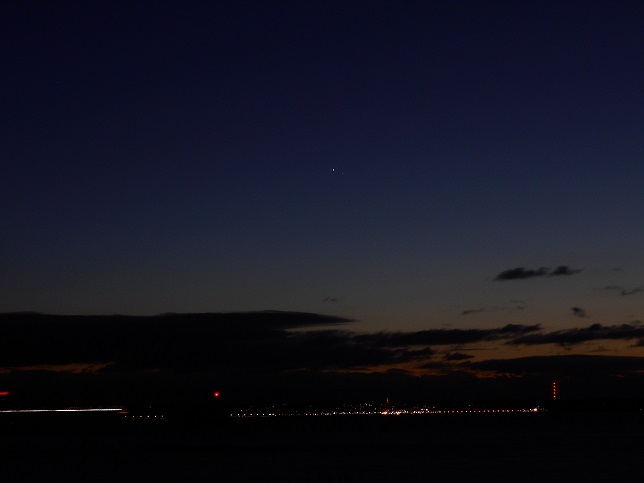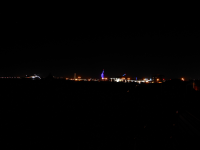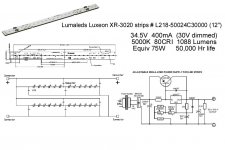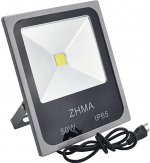BTW, if your LED lamps stay dimly lit when they should be off, add a capacitor across the lamp socket. 0.01uF should be large enough and it should be at least a 300V capacitor if not 600V. Don't go larger than 0.1uF. There are other possibilities such as using one incandescent lamp in the circuit but adding a small capacitor is probably the best plan. The switch wiring has capacitive leakage about 200pF that you need to bleed off.
Last edited:
Some LED lamps used, and perhaps some still do use switch-mode power supplies. That's a problem because besides creating EMC noise, they are not compatible with dimmers.
My favorites are just a series string of LEDs and a small linear regulator, and of course, a rectifier.
Recent generations are either series LEDs with a current regulator or 230V AC connected LED strings.
The older types are with SMPS. So now we have displays in the stores which trailing edge dimmer to use with what LED lighting. This is too complex to the average consumer. One thing unexpected is that dimmer and face plate of different brands can be combined so the unexpected surprise that there is a standard, too bad they cost a lot of money.
Older leading edge dimmers meant for filament bulbs/halogen bulbs with transformer are not suitable for LED (in general). I have experienced that the LED went out with a bang when used with such a dimmer.
Last edited:
Well, I use trailing edge dimmers and was hoping that they would be compatible with available standard dimmable leds. Unfortunately, this only works partially.
Exactly, there is no standard dimmable LED. Some stores here work with colors to combine, for instance, a purple range LED bulb or fixture with a purple range dimmer. Some also take back the dimmer if it does not work with the available LED lighting. Some consumers just use "trial and error" and become frustrated.
So the easy it was to buy a dimmer for filament type of light bulbs, the complex is can be to find the right dimmer for LED. I solved it by using no dimmer at all in my own home also to keep a clean(er) mains voltage. A 20 to 30W LED fixture to light a room when entering, smaller lamps for cosy lighting and a second switch to switch off the 20/30W central ceiling lamp. The dimmers I would need cost over 80 Euro a piece.
So the easy it was to buy a dimmer for filament type of light bulbs, the complex is can be to find the right dimmer for LED. I solved it by using no dimmer at all in my own home also to keep a clean(er) mains voltage. A 20 to 30W LED fixture to light a room when entering, smaller lamps for cosy lighting and a second switch to switch off the 20/30W central ceiling lamp. The dimmers I would need cost over 80 Euro a piece.
Last edited:
The 230V Philips Glowdim LED models that I have tried cannot be switched off electronically. They continue to glow afterwards.
It is stated in the manufacturer's data sheet, but unfortunately there was no indication on the packaging
If there are multiple bulbs on the circuit, a single incandescent bulb will pull the whole circuit output to 0 and shut off the LED bulbs completely.
Could I make a little plea to everyone about light pollution while we install our outdoor lights:
To minimize the harmful effects of light pollution, lighting should
Only be on when needed
Only light the area that needs it
Be no brighter than necessary
Minimize blue light emissions
Be fully shielded (pointing downward)
Light Pollution | International Dark-Sky Association
No need for most of the glare. We have a seafront position near Southsea Castle where there is no lighting at all. Perfect for star-gazing.

The famous Christmas star 2020:

But look what the maniacs have installed nearby. An illuminated roof over the WW2 landing craft outside the D-day museum. Pure light-pollution... 😡
To minimize the harmful effects of light pollution, lighting should
Only be on when needed
Only light the area that needs it
Be no brighter than necessary
Minimize blue light emissions
Be fully shielded (pointing downward)
Light Pollution | International Dark-Sky Association
No need for most of the glare. We have a seafront position near Southsea Castle where there is no lighting at all. Perfect for star-gazing.
The famous Christmas star 2020:
But look what the maniacs have installed nearby. An illuminated roof over the WW2 landing craft outside the D-day museum. Pure light-pollution... 😡
Attachments
My experience of LED light bulbs....
My whole home is lit with LED.
Downstairs, a dozen of so Halogen downlighters that the previous owner put in. Great for flooding the room with light.
BUT, I have found that GU10 size 'Dichroic' replacements quality is very fit and miss.
Avoid "Everready" branded, and budget brands from Aldi/Lidl. The last load I bought from them, lasted 6 months before flickering and dying, one element at a time.
Phillip's, Sylvania and IKEA branded are much better with no failures in nearly 3 years. (Nearly 9k hours of use)
Our kitchen, had a small 3ft fluorescent tube which was becoming very erratic and ended up stroboscopic.
Well I didnt realise the Greens (who I usually support) had made fluorescent tubes almost contraband....
I replaced the kitchen light with a Sylvania fitting, a round dish type ceiling fitting. So far, I am very impressed. I hope the lifetime is good enough, because these have no replaceable bulb.
I'm pretty sure the bulb concept will disappear, in the drive to force low energy lighting upon the world. (Building regs changed in new builds, category H, IIRC, meaning you MUST have a minimum number of energy saving lights)
For the bedrooms I have some olde worlde looking vintage COB Bulbs. And these look great, and throw the light in the same way a filament bulb.
My whole home is lit with LED.
Downstairs, a dozen of so Halogen downlighters that the previous owner put in. Great for flooding the room with light.
BUT, I have found that GU10 size 'Dichroic' replacements quality is very fit and miss.
Avoid "Everready" branded, and budget brands from Aldi/Lidl. The last load I bought from them, lasted 6 months before flickering and dying, one element at a time.
Phillip's, Sylvania and IKEA branded are much better with no failures in nearly 3 years. (Nearly 9k hours of use)
Our kitchen, had a small 3ft fluorescent tube which was becoming very erratic and ended up stroboscopic.
Well I didnt realise the Greens (who I usually support) had made fluorescent tubes almost contraband....
I replaced the kitchen light with a Sylvania fitting, a round dish type ceiling fitting. So far, I am very impressed. I hope the lifetime is good enough, because these have no replaceable bulb.
I'm pretty sure the bulb concept will disappear, in the drive to force low energy lighting upon the world. (Building regs changed in new builds, category H, IIRC, meaning you MUST have a minimum number of energy saving lights)
For the bedrooms I have some olde worlde looking vintage COB Bulbs. And these look great, and throw the light in the same way a filament bulb.
I have nearly fully converted to LED in the past 5 years, only a few halogen fixtures where a LED equivalent bulb didn't mechanically fit remain. I agree that the purpose built LED fixtures provide the best solution. In my shop I have installed 4' LED fixtures that replace florescent tube shoplights and the lighting difference is remarkable...reading measurements to 1mm or 1/32" with these old eyes is much easier. In kitchen and baths under cabinet LED "puck" lights are a very good solution at reasonable cost. There was certainly a time when LED replacements provided cost savings at some compromise in lighting quality, but I think we have reached the point where LEDs provide a better solution with energy savings.
In my experience, the IKEA branded ones are reliable but quite dim compared to Philips and Sylvania. I'm not equipped to measure it though.Phillip's, Sylvania and IKEA branded are much better with no failures in nearly 3 years. (Nearly 9k hours of use)
And LED are a blessing in stage lighting. Lighter, more flexible, more efficient. The only downside is that lighting technicians can use even more obnoxious/intrusive patterns...
Well some are lighter in stage lighting. But must are damn heavy because of the built in electronics and heatsinks, sometimes fans. No need for dimmers, tho - it's all controlled by DMX. As a video engineer I love LED lighting. I get a good color temp near 5000K and when the lighting director dims them after we've set white balance, they don't change color! I've waited decades for that.
I'm so grateful the thirty-six 300w Sylvania incandescents I bought on feebay are on their way. Whhew! 😀
I need them for work. They cast the right kind of shadow for my purposes and I have to have that intensity. I have no idea what I'm gonna do when they're actually all gone.
I need them for work. They cast the right kind of shadow for my purposes and I have to have that intensity. I have no idea what I'm gonna do when they're actually all gone.
In my experience, the IKEA branded ones are reliable but quite dim compared to Philips and Sylvania. I'm not equipped to measure it though.
And LED are a blessing in stage lighting. Lighter, more flexible, more efficient. The only downside is that lighting technicians can use even more obnoxious/intrusive patterns...
I agree with respect to the IKEA GU10 I have here. That is because I have 2.5W IKEA 3500k LED, and 5W Phillip's or Sylvania. At least, the IKEA type is a 25- 30W equivalent and the Sylvania a 50W replacement.
With the TV mounted at about 1.7m, I prefer the 2.5W in the TV and sofa area, saving the 5W for the dining/soldering area 🙂 (the glare is too much)
Now all I really need to install is a LED up lighting system, concealed in coving, for movie watching etc.
The previous owner installed a 3 way light switch which I had never seen installed in a house before... this switches another small group, plus living and dining area.
I'm so grateful the thirty-six 300w Sylvania incandescents I bought on feebay are on their way. Whhew! 😀
I need them for work. They cast the right kind of shadow for my purposes and I have to have that intensity. I have no idea what I'm gonna do when they're actually all gone.
The 5W Sylvania LED are stunningly bright, even if warm white. Brighter than 50W halogen. And no heat. Almost.
However, the dimmable COB 30W LED 118mm "Halogen replacement" is awfully dim, perhaps 30W replacement?
Another 30W 118mm Halogen replacement is the real deal, cold white 5000k and like a floodlight.
Shame the exposed LED connections make this device nowhere near CE verified.
Last edited:
That's the problem, they tend to leave faint shadows. I need them to have the right contrast, the shadows I mean.
After doing some extensive, legitimate studies involving led lighting in application, back before they were consumer grade, it became clear that they just don’t project or throw the light as well as a larger single source like a filament.
A lense is required in order to begin to compete.
I still use them around the house, as they have improved, yet they still aren’t optimized IMO.
And don’t get me started on the power supplies...
A lense is required in order to begin to compete.
I still use them around the house, as they have improved, yet they still aren’t optimized IMO.
And don’t get me started on the power supplies...
This is the very nice LED strips that I installed under my kitchen cabinets
Reasonably priced, along with the aluminum channels w/frosted diffuser covers, they're about 1/2" thick, 12 inches long.
4 of these, wired in a chain to my own dimming power supply design, I couldn't be more pleased with them.
I would assume they're also great for uplighting, backlighting, or inside cabinets for a nice effect.
They also come in a 24" length, double the lumens/LED's, and current (800mA)
Reasonably priced, along with the aluminum channels w/frosted diffuser covers, they're about 1/2" thick, 12 inches long.
4 of these, wired in a chain to my own dimming power supply design, I couldn't be more pleased with them.
I would assume they're also great for uplighting, backlighting, or inside cabinets for a nice effect.
They also come in a 24" length, double the lumens/LED's, and current (800mA)
Attachments
The problem is... It's not the light bulbs which increase the Electrical Bill, but heaters, ovens & washing machines. I've also replaced all my incandescent lamps with leds.
It is a bit misleading, but in Winter incandescent lamps can help heating.
It is a bit misleading, but in Winter incandescent lamps can help heating.
How is the color affected by that dimmer?
Fully bright, a nice pure white. (5000K)
Dimmed, also just as white, no yellowing.
Luxeon also has the same strips in 3000K, 4000K, etc. from warm white to bright white.
Here's info:
Blocked
Last edited:
...300w Sylvania incandescents...I have no idea what I'm gonna do when they're actually all gone.
I got these at the jungle river site to replace 100W halogens on a tripod work light, they might do the trick for you.
Attachments
- Home
- Member Areas
- The Lounge
- LED light bulbs


